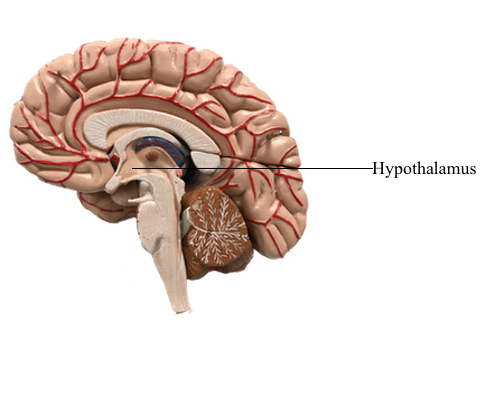Main Model

Diencephalon : 21 Hypothalamus

Hypothalamus
Unlike the thalamus, which is primarily related to somatic functions, the hypothalamus is mainly involved in visceromotor, viscerosensory, and endocrine activities. The hypothalamus and related limbic structures receive sensory input regarding the internal environment and in turn regulate the motor systems that modify the internal environment through four mechanisms. First, the hypothalamus is a principal modulator of autonomic nervous system function. Second, it is a viscerosensory transducer, containing neurons with specialized receptors capable of responding to changes in the temperature or osmolality of blood as well as to specific hormonal levels in the general circulation. Third, the hypothalamus regulates the activity of the anterior pituitary through the production of releasing factors (hormone-releasing hormones). Fourth, it performs an endocrine function by producing and releasing oxytocin and vasopressin into the general circulation within the posterior pituitary.
The hypothalamus can be divided into lateral, medial, and periventricular zones. The lateral zone, often called the lateral hypothalamic area, extends the full rostrocaudal length of the hypothalamus and is separated from the medial zone by a line drawn through the fornix in the sagittal plane. The medial zone is divided from rostral to caudal into three regions: the chiasmatic, the tuberal, and the mammillary regions. The periventricular zone includes the neurons that border the ependymal surfaces of the third ventricle.
Lateral Hypothalamic Zone
The lateral hypothalamic area is composed of diffuse clusters of neurons intermingled with longitudinally oriented axon bundles. The latter, which form the medial forebrain bundle, are diffusely organized in the human brain. No discrete named nuclei are present in this lateral area, although the supraoptic nucleus is considered by some authorities to be part of it. Cells of the lateral hypothalamic area are involved in cardiovascular function and in the regulation of food and water intake.
Medial Hypothalamic Zone
The medial hypothalamic zone contains discrete groups of neurons whose function and connections are established. Within the chiasmatic (anterior) region are five nuclei: the preoptic, supraoptic, paraventricular, anterior, and suprachiasmatic nuclei. Nuclei in the chiasmatic region are generally involved in regulating hormone release (preoptic, supraoptic, periventricular), cardiovascular function (anterior), circadian rhythms (suprachiasmatic), and body temperature and heat loss mechanisms (preoptic). In the tuberal region are the dorsomedial, ventromedial, and arcuate nuclei. The ventromedial nucleus is regarded as the food intake (satiety) center. Bilateral lesions of this hypothalamic region produce hyperphagia, a greatly increased food intake with resultant obesity. Cells of the arcuate nucleus deliver peptides to the portal vessels and, through these channels, to the anterior pituitary. Some of these peptides are releasing factors, which cause an increase in the secretion of specific hormones by the anterior pituitary, and some are inhibiting factors, which inhibit the secretion of specific hormones by the anterior pituitary.
At caudal levels, the mammillary region is composed of the posterior nucleus and the mammillary nuclei. In humans, the mammillary nuclei consist of a large medial nucleus and a small lateral nucleus. Although both of these nuclei receive input via the fornix, only the medial nucleus projects to the anterior thalamic nucleus through the mammillothalamic tract. This latter bundle traverses the internal medullary lamina as it enters the anterior nucleus. The neurons of the posterior nucleus are involved in activities that include elevation of blood pressure, pupillary dilation, and shivering or body heat conservation. The mammillary nuclei are involved in the control of various reflexes associated with feeding as well as in mechanisms relating to memory formation.
Afferent Fiber Systems
Many axonal systems extend into the hypothalamus. Among four inputs that are mentioned, the fornix and the stria terminalis are two major afferent fiber bundles that reach the hypothalamus. The fornix consists of axons that largely originate in the hippocampus, and the stria terminalis arises from neurons in the amygdaloid complex. Fibers comprising the ventral amygdalofugal bundle exit the amygdala and course through the substantia innominata to enter the hypothalamus and thalamus. As mentioned, the medial forebrain bundle passes bidirectionally through the lateral hypothalamic region. This composite fiber bundle consists of ascending axons that originate in areas throughout the neuraxis and terminate in the hypothalamus and other axons that exit the hypothalamus to reach forebrain and brainstem targets.
Efferent Fibers
The hypothalamus is the source of a diverse array of efferent fibers. Several nuclei give rise to descending fibers that contribute to the dorsal longitudinal fasciculus and the medial forebrain bundle and to diffuse projections that pass into the tegmentum. These fiber systems project directly to numerous brainstem nuclei as well as to preganglionic sympathetic and parasympathetic neurons in the spinal cord. Other projections reach the thalamus and frontal cortex, and still others extend to the posterior pituitary or to the tuberohypophysial portal system for delivery of substances to the anterior pituitary.